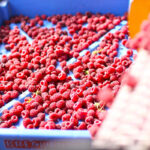The potential of Peruvian raspberries in the frozen category

Peruvian raspberries are a crop in the process of growth, still in its nascent stage and not widely cultivated throughout the country. Despite this, it has begun to gain popularity in recent years, due to progressive growth driven by domestic demand, especially in the fresh market.
“This market, aimed mainly at consumers, is presented as an alternative for farmers in various areas of the country. But raspberries have a lot of potential for export,” Luis Llanos, head of Agromercado, an institution under the Ministry of Agrarian Development and Irrigation (MIDAGRI) told FreshFruitPortal.com.
Luis Llanos warned that “naturally every producer will want to export fresh, it is what gives the best economic return, but exporting fresh implies knowing and mastering the logistics chain, the cold chain, the logistics operation... And the raspberry is a very sensitive product, quite perishable, to start promoting fresh exports. Undoubtedly, some will attempt it, but what we, as the Ministry of Agriculture, want is to start promoting the frozen industry”.
The head of Agromercado stressed that the frozen market is huge, which can consume “everything Peru produces”, which allows the fruit to arrive at its destination with a more attractive appearance.
“It is less perishable. Frozen fruit has a two-year shelf life, compared to the ten-day shelf life of fresh fruit. We believe that the raspberry will help improve the income of small producers of small and medium family farming,” he said.
But what are the markets where frozen raspberries could be sold? Luis Llanos said that they are the same ones that Peru already has with frozen blueberries.
“We are talking about the United States, Canada, several European countries, and even Asia. It is a small fruit that often accompanies blueberries in the portfolio of frozen buyers; they are complementary in the commercial market. The importer, the repacker that imports frozen blueberries in Europe, is the same one that also buys frozen raspberries. So, to start with, Peru has already opened the commercial channel to place all the raspberries it can, because at a commercial level, they complement each other in the exportable supply of blueberries,” he emphasized.
Chile and Eastern Europe
Luis Llanos pointed out that the Ministry of Agriculture is focused on attracting businessmen who are currently investing in crops such as strawberries and potatoes to invest in raspberry cultivation on the coast of the country.
This effort is aimed at areas with freezing infrastructure, such as the irrigated areas of Chavimochic, Jequetepeque, and the coast of Ancash, extending as far as Piura. He explained that these areas, with numerous freezing plants, are key to absorbing the large volumes that raspberry cultivation can generate.
He also mentioned that it has already been proven that raspberries can be grown on the Peruvian coast, as demonstrated by a Chilean nursery that conducted successful trials in Piura. The strategy seeks to encourage proximity between plantations and freezing plants to facilitate processing and potential export of the product.
“IThere are no more than 20 or 30 freezers in Peru, and the main ones are located almost exclusively on the coast. All those plants that today freeze mango and avocado, also process blueberries, and those same plants would be the ones that would freeze raspberries. It is a natural strategy, as they complement their frozen berry campaign. As I mentioned, raspberries fall into that same berry basket,” he explained.
The industry expert highlighted that countries such as Chile and those of Eastern Europe, important raspberry producers, have developed this crop through family farming, with small production units of one or half a hectare.
“In Chile, they freeze a lot of raspberries and complement their other crop campaigns with this fruit. And I would go so far as to say that 90% of Eastern European growers have no more than one hectare. This is how raspberries have grown in Chile and Eastern Europe,” said Llanos, suggesting that this model fits perfectly with family farming in Peru.
The most widely promoted raspberry variety in Peru is Heritage, a free variety that has shown good results. Although initially protected varieties such as Santa Clara, Santa Catalina and Santa Teresa were considered, legal difficulties and the costs associated with royalties led to the choice of Heritage, which is easier to acquire and grow.
Llanos pointed out that in Peru this variety reaches larger sizes than in Chile, with diameters of up to 4 cm. Currently, there are already small producers in regions such as Lambayeque, Huánuco, Áncash, Arequipa and Tacna, although the total area of raspberry cultivated in Peru has not yet been formally registered.
Luis Llanos indicated that the first key step for the public sector is to establish a raspberry demonstration plot in Donoso, Huaral, north of Lima, with the expectation of having it ready by May next year. This pilot plot will be open to entrepreneurs so that they can observe, analyze costs and contact suppliers. In addition, other plots are planned in Jequetepeque, Chavimochic and one in Piura, to offer alternatives to small producers who are losing land dedicated to bananas.
“Although raspberries are not as economically viable as bananas, the ministry seeks to provide new agricultural options,” he concluded.













































